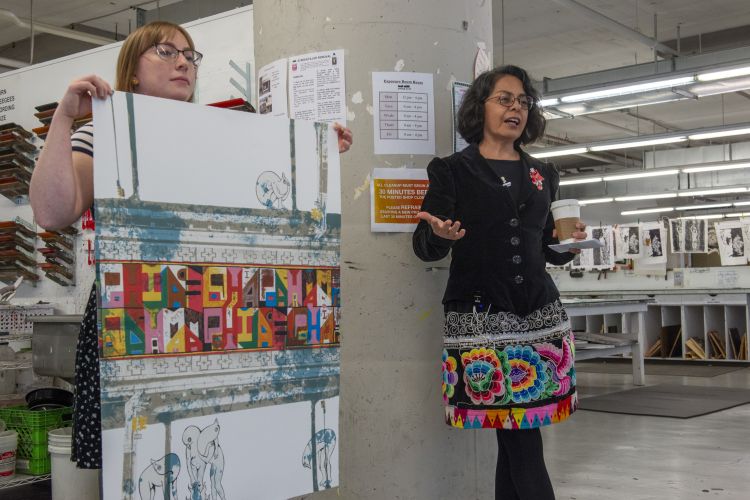STORIES FROM PAFA
Preserving More Than 200 Years of Art History
The Dorothy & Kenneth Woodcock Archives at PAFA receives more than 300 requests each year from patrons seeking information and assistance locating historical information to support research projects.
Hoang Tran, PAFA’s Director of Archives, maintains hundreds of thousands of documents, photographs, and books that are called upon by students, curators, historians, and genealogists.
PAFA’s art collection tells one story but the historical archives can answer many questions.
“We had a curator from the Biggs Museum of American Art and he wanted to know how lighting was set in art schools,” Tran said. “You’ll see in photographs that sometimes we have skylights for natural light, sometimes we had electric. Then when did we have oil lamps? The curator was tracing how art school studios were lit. That’s something the art collection can’t tell you.”
Preserving and sharing PAFA’s history is a difficult balance. Some documents and photographs are being called upon for research nearly a dozen times a year and Tran said there is wear and tear each time items are being reviewed.
“We have collections over a hundred years old that gets called out 10-15 times a year and each time you use it, the integrity of the items are compromised. To promote preservation for these high-use collection, we want to digitize them,” he said.
In 2016, PAFA received a $25,000 grant from the Institute of Museum and Library Sciences to launch the institution’s first digitization initiative specifically for its archives. The grant, through the Museums for America program, allowed PAFA to digitize over 3,000 photos dating between 1877 and 1969.
The digitized collection centered on the historical Annual Exhibitions at PAFA. Starting in 1811 until the final exhibition in 1969, PAFA's historic Annual Exhibitions brought more than 100,000 works of art to Philadelphia audiences.
Photographs from that collection are one of the most common archive requests PAFA gets.
“Conservators or auction houses will ask about the original frame of a work exhibited and ask if we have the installation photographs to verify the provenance. Let’s say a painting was repaired and they weren’t 100 percent sure of what it looked like originally before it was repaired then that’s a question I might get from a conservator,” he said. “Auction houses will ask if paintings were exhibited at PAFA or in its original frame. It might look old but sometimes people simply place an old frame on the painting to make it look more valuable. An auction house will trace it back to PAFA and ask if we have a photograph.”
Tran said it is a race against the clock to preserve PAFA’s earliest photos.
“These are 100 year old photographs and they weren’t kept in the best conditions. The photographs weren’t viewed like a piece of artwork where there is a higher standard for preservation,” he said. “Most of the photographs were created for documentation purposes so people were sometimes very cavalier and didn’t care how they turned out or how they were housed. They just wanted to create photographic evidence of works exhibited at PAFA.”
In addition to digitizing PAFA’s collection, Tran is in charge of maintaining and organizing all documents and artifacts. Whether it’s with brass doorknobs and stone fragments from the Historic Landmark Building, or student records holding the stories of thousands of artists, Tran uses the archives to share the story of PAFA.
The Academy’s archives even hold some global history.
“We have 20 volumes of etchings by Giovanni Battista Piranesi that were donated to PAFA in 1810 by Napoleon Bonaparte, the Napoleon,” Tran said. “He donated them and said he wanted them to go to a great public institution in the United States.”
Gifts from French military leaders are interesting additions to the archives, but Tran said archive requests from people trying to learn more about family members who went to PAFA are the most meaningful to him.
“One request I had was from a woman from the United Kingdom. Her mother attended PAFA in the 1940s and then immigrated to the UK after completing her training. Her mother passed away when the daughter was young and she needed to verify her mother’s attendance in order to obtain dual citizenship for her mother after death,” he said. “The woman called her cousin who lives in Abington, PA and she came in to help with the research. We were able to locate information that verified her attendance at PAFA. Her family was able to get the late mother dual citizenship.”
Over the next five years, Tran has an ambitious plan to digitize every photograph in PAFA’s archives, more than 20,000 pieces of history preserved.
Digitizing photographs not only makes them last longer but makes them more accessible to the public.
“I’d like to do more outreach and teaching. We hold seminars here now for art teachers but I also want to focus on students and try to make them understand that not everything is on Wikipedia, not everything is on Google images. You have to come in and physically use the collections to appreciate and truly understand the stories you can get from archival resources. I want to teach students to be better researchers.”
We're so excited you're planning to visit PAFA!
Make time for art — visit us Thursday to Sunday.
Before reserving your tickets, please review helpful information about museum hours, accessibility, building access, and special admission programs.
If you have any questions, feel free to reach out to us at visitorservices@pafa.org — we’d love to help!

![1968 Annual Exhibition jury (L-R: David Hare, Theodore Roszak, [Unidentified Person], Will Barnet,Arthur Osver)](/sites/default/files/styles/gallery/public/2019-09/1968_163rdExhibitionJury.jpg?itok=PCwGj6xl)



